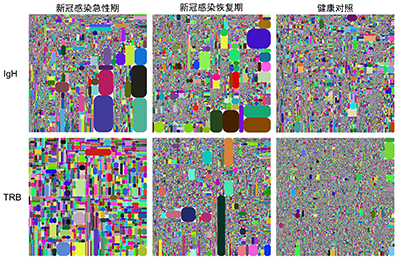The Team of Respiratory Virus and Infectious Disease of the State Key Laboratory of Respiratory Disease Reveals the Characteristics and Dynamic Changes in Patients with COVID-19 wit...
2020-11-051292Recently, the team of respiratory virus and infectious disease of the State Key Laboratory of Respiratory Disease, which is led by Chen Ling, and the research team led by Han Jian from the Institute of Medical Immunology, Jiangsu Industrial Technology Research Institute, co-published a paper on the research results of the analysis on the characteristics and dynamic changes in the immune repertoire of patients with COVID-19 in journal Frontiers in Immunology, “Longitudinal Analysis of T and B Cell Receptor Repertoires Transcripts Reveal Dynamic Immune Response in COVID-19 Patients”. The paper reports the characteristics and dynamic changes in the TCR and BCR of patients with COVID-19, providing a reference for clinical treatment.

Researchers collected the peripheral blood samples at multiple time points after the onset of COVID-19, and applied dam-PCR immune repertoire amplification technology to the mRNA of all seven peptide chains of the immune repertoires of TCR-α, β, δ, γ and BCR-IgH, κ, and λ for unbiased quantitative comparison, and to longitudinally display the acquired immune response during the early onset and recovery of patients with COVID-19 in a dynamic panoramic manner. The research has found that in the early stage of infection, the expression of TCR-α and TCR-β (TRB) in the patient’s immune repertoire decreased significantly. The expression of TCR-β in ordinary patients was close to the normal level in the recovery period, while the expression of TCR-β in patients with severe COVID-19 continued to be at a very low level, indicating that the expression of TCR-β can be used as an indicative biomarker to predict the course of COVID-19. In the early stage of the onset of COVID-19, IgM first responded to viral infection and the subtype of antibody was converted to IgG. Another important finding is that the expression of IgA temporarily increased significantly in the early stage of infection, which is of great value for early diagnosis and discovery of therapeutic antibodies.

Each dot in the above figure represents a unique IgH/TRB CDR3 sequence, and its size indicates the related proportion in the repertoire. In the acute phase of COVID-19 infection, IgH virus-specific clonal amplification occurred, which maintained in the recovery period. However, in healthy controls, the clonal amplification is not significant and the diversity is good. the TRB sequence shows a significant decrease in the number of clones in the acute phase of the infection, but its clonal amplification remains in the recovery period, while its diversity returned to a level similar to that of healthy controls.
The research has shown that immune repertoire analysis is a new method to evaluate the host’s acquired immune response to infectious diseases. The research systematically displays the changes in the immune repertoire of BCR and TCR in patients with COVID-19, which provides guidance for clinical treatment, and contributes to the development of antiviral treatments and vaccines. In the future, we will cooperate with counterparts at home and abroad to search for neutralizing antibodies against pathogens by calculating and analyzing the changes in the antibody repertoire in the peripheral blood of patients in the recovery period.
















